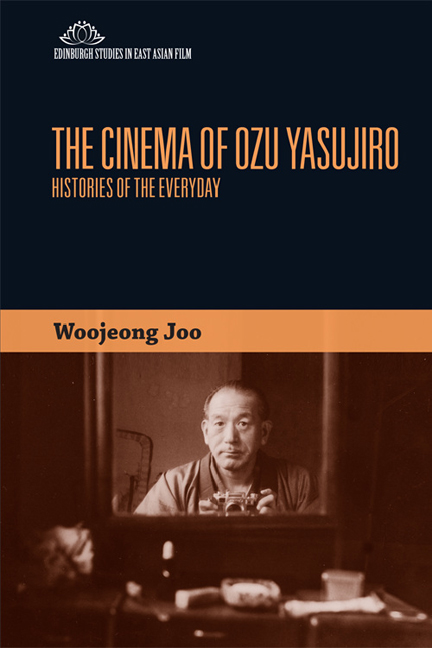Book contents
- Frontmatter
- Contents
- List of Figures
- List of Tables
- Acknowledgements
- Introduction: Ozu, History and the Everyday
- 1 Early Ozu: Shōshimin Film and Everyday Realism
- 2 Ozu in Transition: The Coming of Sound and Family Melodrama
- 3 Wartime Ozu: Between Bourgeois Drama and National Policy Film
- 4 Postwar Ozu: Ozu's Occupation-era Film and Tokyo Regained
- 5 Late Ozu: New Generation and New Salaryman Film
- Conclusion
- Notes
- Glossary of Japanese Terms
- Select Filmography
- Select Bibliography
- Index
1 - Early Ozu: Shōshimin Film and Everyday Realism
Published online by Cambridge University Press: 07 December 2017
- Frontmatter
- Contents
- List of Figures
- List of Tables
- Acknowledgements
- Introduction: Ozu, History and the Everyday
- 1 Early Ozu: Shōshimin Film and Everyday Realism
- 2 Ozu in Transition: The Coming of Sound and Family Melodrama
- 3 Wartime Ozu: Between Bourgeois Drama and National Policy Film
- 4 Postwar Ozu: Ozu's Occupation-era Film and Tokyo Regained
- 5 Late Ozu: New Generation and New Salaryman Film
- Conclusion
- Notes
- Glossary of Japanese Terms
- Select Filmography
- Select Bibliography
- Index
Summary
For Ozu, the cinema and the earthquake came together. It was in August 1923 when, having spent ten years outside of Tokyo for his education, Ozu finally returned to his hometown to take up a job as an assistant cameraman in Shochiku's Kamata studio. Only a month later, the Great Kantō Earthquake occurred, devastating everything, not only buildings and houses but also the memory of Edo (Tokyo's old name) that was already dying out. Tokyo's old Shitamachi district would disappear, many people would leave, and the film studios (all except Shochiku) would find their new home in Kyoto. Meanwhile, from the heap of rubble, the energy to create a new world was slowly growing. This is the apocalyptic Tokyo that Tanizaki Jun'ichiro gazed at and then exclaimed, ‘Tokyo will be better for this!’ The commercial centre of the city would soon move from Nihonbashi to Ginza, where several department stores, off ering goods for everyday living rather than only expensive speciality or imported items, would lure Tokyo citizens to partake in the new commodity culture. This was the beginning of a new world called ‘the modern’, and Ozu's filmmaking incidentally (but meaningfully) corresponded with this important phase of transformation in the early twentieth-century history of Japan.
Needless to say, the modern did not begin the day the earthquake happened. Studies have shown that the modern of the 1920s, the period which saw the enthronement of the new emperor Shōwa as well as the earthquake, owed much to what the previous Taishō era (1912–26) had been experiencing under such mottoes as ‘bunka (culture)’, the concept of which was itself a reaction to the previous Meiji period's (1868–1912) national agenda dubbed ‘bunmei (civilisation)’. According to Minami Hiroshi, what distinguished bunka from bunmei was the former's ‘individualism and consumerism’, which contrasted with the latter's emphasis upon ‘national enrichment, security, and industrial production’.
- Type
- Chapter
- Information
- The Cinema of Ozu YasujiroHistories of the Everyday, pp. 21 - 58Publisher: Edinburgh University PressPrint publication year: 2017



